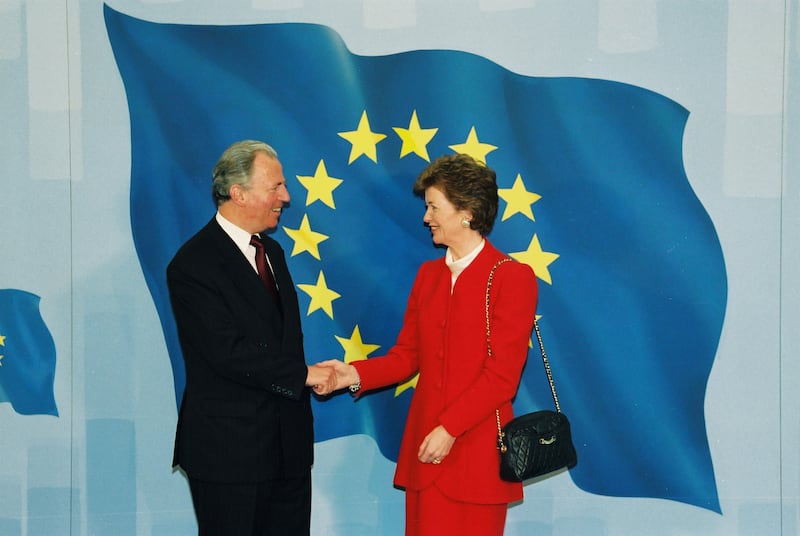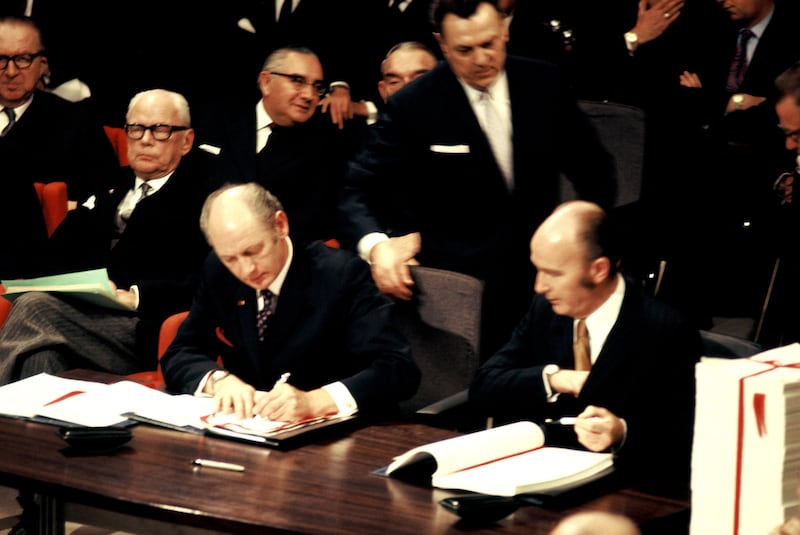If a week is a long time in politics, what about 50 years? As an intriguing new exhibition shows, while some events from the early days of Ireland’s EU membership feel as if they have come from the deep mists of time, others seem like they only happened yesterday. A black and white photo of two cardigan-clad women in sensible shoes, going to vote at a rural polling station looks like something from the 1940s or 50s, rather than 1972; while president Mary Robinson, resplendent in a red suit to meet European Commission president Jacques Santer, seems completely contemporary. In fact, it was taken in 1995.
Historian and author Miriam Nyhan Grey, who curated the exhibition, trawled the archives of the commission, as well as the National Archives, the Royal Irish Academy, the National Library, the archives of newspapers – including this one, and more; to source images and documents that tell the story of Ireland in the EU over the last half century. “What I’ve tried to do is take a magazine-style approach to how the EU has shaped our lives,” Nyhan Grey explains.

Presented across 12 panels, the exhibition gives the lie to the idea that EU matters are typified by images of anonymous men in suits. Instead we begin with posters campaigning for a Yes vote in the accession referendum, as well as evidence of the campaign against it. Nyhan Grey has an engagingly eclectic eye, and that story-teller’s ability to create a narrative through documents and photographs, which marks out a good historian. QR codes bring a further layer, linking to relevant pieces from the RTÉ archives.
Alongside all this, short texts add more background, such as the fact that while we don’t always agree on everything in this country, just more than 50 years ago we almost all agreed on one thing: joining the then European Community was a very good thing. The Irish Farmers’ Association urged “Yes” with a sketch that threatened a return to the poverty of subsistence farming if we didn’t join; while in a letter to workers, Gordon Lambert of Jacob’s warned his biscuit workers that change was coming regardless, and that growth would only be possible through access to tariff-free European markets. Sinn Féin and the Labour Party lined up on the No side, but the vote was carried by an astonishing 83.1 per cent.
READ MORE
Subsequent panels explore farming and fisheries, human rights, equality, the role of women, the Irish language, culture, education, European enlargement, the various treaties and Ireland’s role on the international stage. Brexit is there, including in its impact on the Belfast Agreement, and the role of the EU in mitigating the effects of this. “It’s not exhaustive,” says Nyhan Grey. “But it does explore the main ways in which being part of the EU has formed us, and how we see ourselves today. We entered the EU 50 years after independence, 50 years ago, so it’s recent history in that sense.”
A theme throughout is identity, and how our identity as Irish people sits surprisingly comfortably alongside the identity of us as Europeans. “The ease with which we wear a sense of being European, with our Irishness is very interesting,” Nyhan Grey says. “One of the fears was that this journey would somehow water down our sovereignty, and our sense of Irishness and national identity. But actually, it just became part of another layer of how we see ourselves. It shows the complexity of us as humans, to see ourselves in multiple ways. That’s one of the big takeaways.”

While noting her historian’s warnings against oversimplifying things, she points out how EU membership shifted Ireland’s focus from the UK and the US, adding another dimension to our sense of place in the world. Did those proposing accession realise this would be an outcome, she wonders. If so, they were visionary. Another huge, and positive impact has been on the lives of women, as another illuminating panel in the exhibition shows. Headlined by that image of president Robinson, the panel also includes a circular from the Department of Foreign Affairs noting the Treaty of Rome’s requirement that member states “implement and maintain the principle of equal pay for men and women… .” The circular is dated 1971. Some would argue that we’re not there yet.
Nyhan Grey points out other key figures in the story of Ireland in Europe. There’s former taoiseach Garret FitzGerald, and Peter Sutherland, who had been variously attorney general, a UN special representative and European commissioner. As she describes Sutherland’s role in bringing the Erasmus study and work abroad programme into being, Nyhan Grey expands into a narrative of other key figures in the story, from John Hume to George Mitchell and Jean Monnet, regarded by many as “the father of the Europe”. They come to vivid life in her descriptions, and in this fascinating series of glimpses into the people and events that have shaped all our lives over the past 50 years.
Into Europe: Ireland and the EU 1973-2023 is a Documents on Irish Foreign Policy project, curated by Dr Miriam Nyhan Grey, and presented under the auspices of the Royal Irish Academy, the Department of Foreign Affairs and the National Archives. The exhibition will be on display in venues across Ireland, including libraries and third level institutions, as well as locations abroad. Ireland.ie/eu50
















